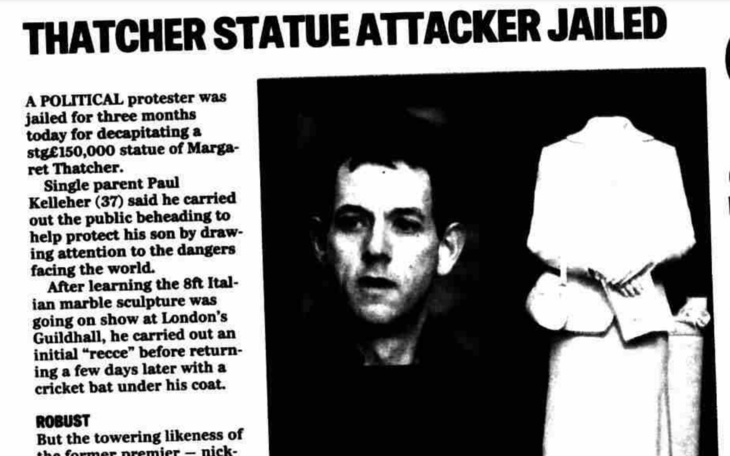
Spencer Percival may have been the only British prime minster to be assassinated, but did you know that Margaret Thatcher was once decapitated? Well a statue of her, anyway.
In February 2002, a Carrara marble statue of the Iron Lady (complete with marble handbag) was revealed at London's Guildhall Art Gallery. Costing £150k (stumped up by an anonymous donor), weighing two-tonnes, and looming eight-feet-tall, Neil Simmons' sculpture was almost as redoubtable as the woman herself.
Thatcher agreed to six sittings with sculptor Neil Simmons while he captured her likeness, and apparently the Baroness wasn't as terrifying as he'd feared: "She was a very human person," he said. Whatever you say, Neil.
Why did the statue wind up in the Guildhall?

The idea was that the statue would go up on a plinth in the Members' Lobby of the House of Commons. The problem was, Thatcher wasn't yet dead.
With rules decreeing no living former PM could be idolised in statue-esque form in the Halls of Power, the effigy of Maggie had to find another home.
They couldn't put the thing in Portcullis House, just across from the Houses of Parliament, because it was so heavy, it'd mean reinforcing the floors.
An offer from Lake Havasu City in Arizona (the same Lake Havasu City that owns the old London Bridge) to take the statue off London's hands was politely declined.
"I think it looks better like that"

In the end, the statue — which enjoyed another unveiling by its subject in May 2002 — stayed put at the Guildhall Art Gallery, where it was to await further developments.
Further developments there most certainly were.
On 3 July 2002, 37 year-old Paul Kelleher charged into the gallery and carried out a premeditated attack on the statue with a Slazenger V600 cricket bat, which he'd secreted under his coat.
True to form, the Iron Lady proved stubborn, and wouldn't wield to the willow. Kelleher picked up a metal pole from a crowd control barrier, and used that to whack the sculpture instead, with a "well-aimed roundhouse". This had the intended effect, sending Maggie's head flying.
When police arrived on the scene moments later, the assailant quipped: "I think it looks better like that."
But the judicial system didn't see the funny side, and in February 2003 Kelleher was sentenced to three months in jail. At his hearing, the defendant claimed the beheading was 'a protest against the ills of the world's political system'. He added: "I am becoming increasingly worried as to what sort of world I have brought my son into".
Thatcher lives on in London

And what became of Maggie's statue? Well, the head was fixed back on, but it never made its way to the House of Commons, even following the former PM's death at the Ritz hotel in 2013.
In the meantime, the House of Commons rules were flexed, to allow a bronze likeness of Thatcher to be unveiled in the Members' Lobby of the Houses of Parliament in 2007, when she was still very much alive.
In 2013, it seems that Guildhall Art Gallery tried to palm the marble statue off onto the Grantham Museum in Thatcher's hometown. The museum rejected the offer, with the manager saying it was "asking for trouble". Which means you can still go and see Maggie's re-headed sculpture at Guildhall Art Gallery (although it's temporarily closed till April 2022).
A less-flattering Thatcher effigy — namely a Spitting Image puppet — is on display at at the Imperial War Museum, while she also makes a bizarre appearance on the Tower Hill sundial, where she can be found between war and pestilence.




